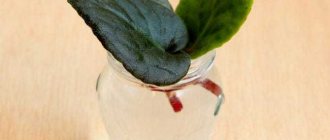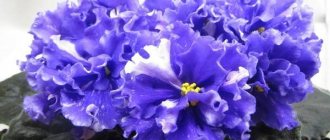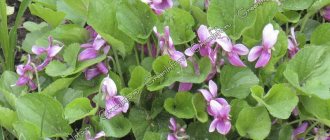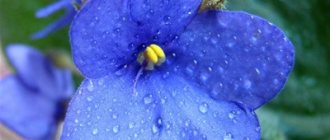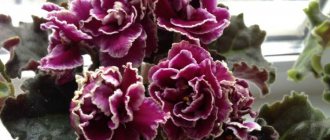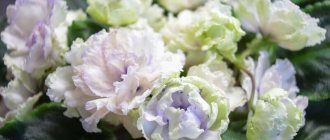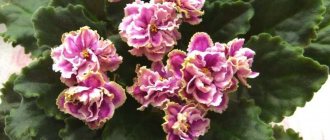Violet, description and photo EK-Goddess of Beauty (E. Korshunova)
Violets from breeders of the CIS countries - “B” (EK-3).
EK-Goddess of Beauty (E. Korshunova).
EK-Goddess of Beauty, EK-Boginya Beauty (E. Korshunova).
Double wavy-curly bright pink stars with a purple-violet coating throughout the flower.
Dark green rosette. Standard. The socket is like a helicopter, falling apart, deteriorating with age. The leaf blade is not very large, and the petiole of the leaf is long, resulting in an untidy appearance.
Huge (7 cm) densely double wavy stars, bright pink-crimson with purple-violet tints throughout the flower. The whole flower is so voluminous, it looks like it’s made of wax.
The peduncles are long and rather weak, the flower is heavy and the flowers do not “stand” for long. As soon as the flower opens completely, it falls and lies on the leaves. Peduncles with 3-5 buds. Violet does not like to bloom much, twice a year. An adult violet blooms for a long time. It likes to bloom in late autumn or winter. The bouquet is large and beautiful. In spring and summer it doesn’t work like that.
On the window, the rosette is not so spread out, and the flower stalks are not so long. Requires a lot of light. Moreover, it must be placed under good light from childhood. Even the children of this variety have long petioles. The sport has light leaves and petioles.
Venus (carnal love) - in Roman mythology, the goddess of beauty, carnal love, desire, fertility and prosperity. Subsequently, she began to be identified with the Greek Aphrodite. In Hindu mythology, the goddess of happiness and beauty is Lakshmi, the wife of Vishnu and the mother of the god of love Kama. The Scandinavian goddess of fertility, love and beauty Freya in the mythology of the ancient Germans is the wife of the supreme god Odin. In Slavic mythology, Lada is considered the goddess of love. Lada has deep sensuality and emotionality. For her there are no half measures: if you love, then to the grave, if you hate, then to the end.
Do you know that…?
Good symmetry and character of development. A distribution of leaves growing straight from the center of the rosette to the outer edge, with each row of leaves parallel to the previous one. No spaces or spaces. The leaf blades are larger compared to the length of the petiole. Plants with these characteristics exhibit good symmetry with fewer rows of leaves and at an earlier age. It is clear that the space inside a certain circle is easier to fill with large leaves. The gaps between the rows will be smaller if the leaves fit tightly to each other, overlapping each other like tiles. Comparatively short petioles mean that the plant exhibits good symmetry at an earlier age. The second characteristic feature that gives good symmetry is the rigidity of the petioles. Leaves with such petioles are most likely to grow straight from the center of the plant to the edge. Plants with this trait will also show symmetry even in low light, in natural light.
Before you buy the violets listed below, carefully read the forums about their behavior on the windowsill. Many of them are very beautiful flowers. However, these can be large rosettes with large and fragile leaves, with leaves rising up or hugging the pot, forming many stepsons that interfere with the formation of a neat rosette, pulling the stem up and growing into a Christmas tree, bending the trunk, rare flowering with long breaks, fallen flowers or they last little and quickly wither, very long and recumbent peduncles, the color of the flower fades quickly, they do not like bright lighting on the windowsill, they are afraid of the slightest drying out or waterlogging, a large percentage of them go into sports or darken the flower.
Are they suitable for your window sill and the conditions that you can create for them? You will look at the flowers for several months, and the rosette will always be in front of your eyes. There are many beautiful flowers, there are much fewer beautiful and neat rosettes, look first at the rosette! Search and you may find a dozen violets with the same flower color if you are not interested in the smallest details as a collector.
•— Velvet Blues (Korshunova); •— Ivory Coast (Korshunova); •— Blessing (Korshunova);
Features of care
Varieties of violets: photos, names and descriptions (catalog)
Like any plant, this variety needs certain conditions; let’s look at them in more detail.
Priming
The goddess prefers soils with turf, pine needles, peat and humus, and requires annual replanting to avoid infection, disease and mold. In order to simplify the choice of soil, you can simply purchase specialized soil for violets - it will be quite suitable for the plant.
Pot
The “Goddess of Beauty” has no special preferences in terms of pots; pots traditional for violets with a diameter three times smaller than the rosette of the plant are suitable - this is traditional for all violets; in too wide ones they grow poorly and almost do not bloom.
Don’t forget to put a little expanded clay or special moss on the bottom for drainage; all this can be purchased at any flower shop.
Lighting
This variety of violets loves bright light without directly directed rays of the sun, as they cause burns and spotting in the delicate “goddesses.” For better flowering, experienced gardeners install lamps directly above them (fluorescent ones are best suited). They need 12 hours of light per day.
Attention! In order to understand that the plant needs more light, pay attention to the leaves: when a violet pulls its leaves up, it means that it does not have enough light.
Temperature
Violet does not require special temperature conditions: 20-24 degrees Celsius - normal conditions in an apartment - the ideal regime for violets. Similarly with humidity: no unnecessary manipulations, the conditions in the apartment are quite sufficient for active flowering and flower health.
Care
This Saintpaulia, like the others, requires proper care. The main thing in this matter is the right location and optimal humidity.
Selecting a location
.Choosing a place for Humako Inches is not so easy, however, this factor is the key to regular flowering. The place should be lit, but without direct sunlight. Excessive light causes rotting of leaves and petals. In addition, drafts and too high temperatures should not be allowed.
There should be no more than one rosette in one pot, and the lateral shoots must be removed. The same applies to injured and dried areas, however, all this must be removed carefully, without touching healthy areas.
To ensure good flowering, diffused light is required for at least 12 hours a day. In order to make this period longer, in winter the plant must be moved to the south or west side, while providing artificial lighting. However, directly during flowering, the pot with the plant should not be rearranged under any circumstances.
Humidity and temperature
The optimal temperature for this Saintpaulia is considered to be +18–24 degrees Celsius. In winter, it should not be less than 10 degrees, as the plant will simply die. If the temperature, on the contrary, is too high, the violet will not bloom.
Humidity should be at 50%, this can be ensured by placing the pot on a tray with wet pebbles. In addition, spray bottles should be avoided.
Watering
As for watering, it must be regular and at the root level. The soil should be moist, but not very wet. In order to avoid rotting and the appearance of pests, all moisture that gets on the leaves should be wiped off immediately. The following methods can be used for irrigation:
- immersing the pot in water;
- watering from a tray;
- humidification with a wick;
- using a syringe.
To prevent mold from appearing on the soil, it is recommended to moisten the plant with phytosporin water at least once a month.
Top dressing
In summer and spring, Humako Inches need to be regularly fertilized with mineral supplements. They should be applied at least 2 times a week according to the following scheme: 2 grams per 1 liter of water.
Shortly before the budding begins, mineral complexes and fertilizers should be used in large quantities in order to increase the number of buds. To ensure the necessary flowering, fertilizers should be half as much.
Transfer
Another important detail for successful plant growth is replanting. It needs to be done about twice in one year, when the soil in the pot becomes depleted. The best time for this is spring.
The pot should be the same size as the old one, and the soil should be suitable for Saintpaulias. There must be drainage - it should occupy about half of the pot.
If the transplant is planned, then it must be carried out using the transshipment method. In case of unscheduled work (soil acidification or plant disease), complete or partial soil replacement is used
It is very important not to forget to check the condition of the roots and separate the daughter parts of the violet necessary for propagation
Reproduction
This violet is most commonly propagated by leaf cuttings. It is necessary to take a healthy and mature leaf from the very bottom of the plant, treating this area with charcoal after removal. Then a dark glass container with boiled water is prepared, and the cutting is placed there. Just a few weeks later, with the appearance of the first roots, the violet can be safely moved into a pot with soil.
There is also a method of propagation by seeds, but it is used much less frequently.
You will learn how to choose high-quality Humako Inches violets in the store and not make a mistake in the following video.
Violet, description and photo Humako Inches (Humako)
Types and varieties of violets (Saintpaulia)
Saintpaulia varieties of foreign breeders “H” (Humako).
Humako Inches (Humako).
. (Inch).
White flower with a wide blue center.
Light green, smooth, rounded foliage. The leaf blades are very large. Standard. The socket is smooth and quite neat. The rosette is quite large, but can be grown compact if it is not allowed to grow long petioles.
A very spectacular variety with huge flowers. Large flowers 6-8 cm in size. All flowers are almost the same size. In hot weather, the flower appears blue.
From the first flowering it blooms immediately with a cap. Flowers completely cover the rosette. Flowers last a very long time, even in hot weather. Flowering is long-lasting, flower stalks constantly appear, replacing those that have already faded.
Propagates easily, grows quickly, blooms after 8 months.
There are two “variants” circulating among collectors, or rather two different plants with the same name. Real Humako Inches - with a smooth edge of the petals. The second variety was a test variety, no name, similar to Humako Inches, but the flowers are smaller and the petals have a wavy edge. It was not put into production (as it does not tolerate transport on an industrial scale), but spread among collectors. They suggest calling it Humako Inches 2, Humako Inches No name, Saintpaulia (Humako).
Do you know that…?
Many varieties fade in summer and there is less white if this color is present in the flower. Some are darkened, while others lose part of the color scheme. Darkening of color in summer is a fairly common occurrence in the violet world. At low temperatures, violets lighten. The same variety can bloom differently on your windowsill and on your shelf, in summer and winter. The same applies to green ruffles. The law of low temperatures works here - the lower the temperature, the more expressive and wider the green ruffle.
Before you buy the violets listed below, carefully read the forums about their behavior on the windowsill. Many of them are very beautiful flowers. However, these can be large rosettes with large and fragile leaves, with leaves rising up or hugging the pot, forming many stepsons that interfere with the formation of a neat rosette, pulling the stem up and growing into a Christmas tree, bending the trunk, rare flowering with long breaks, fallen flowers or they last little and quickly wither, very long and recumbent peduncles, the color of the flower fades quickly, they do not like bright lighting on the windowsill, they are afraid of the slightest drying out or waterlogging, a large percentage of them go into sports or darken the flower.
Are they suitable for your window sill and the conditions that you can create for them? You will look at the flowers for several months, and the rosette will always be in front of your eyes. There are many beautiful flowers, there are much fewer beautiful and neat rosettes, look first at the rosette! Search and you may find a dozen violets with the same flower color if you are not interested in the smallest details as a collector.
• — Happy Returns (Volkmann); • — Harbor Blue (Weber); • — Harmony's Frilly Dealy (Harmony's Greenhouse). • — Hood Wink (Dates). • — Hot Summer Day (Stork); • — Huron (Eyerdom);
Possible problems in growing
When growing Saintpaulias at home, many problems can arise. Most of them are the result of violation of care conditions: increased humidity levels, poor lighting, drafts, improper watering.
Important! A violet planted in a container that is too wide will not bloom until it fills the entire surface of the earth.
Problems with leaves
Among the difficulties that you may encounter are disorders associated with the leaves of the plant:
- yellowing;
- appearance of spots.
In the first case, the plant may require rejuvenation or relocation to a less lit place. You should also reduce the dosage of applied phosphorus fertilizers. Spots appear when various pests appear.
Pests
The violet is most often attacked by certain insects:
- different types of ticks;
- scale insects;
- nematodes.
If the degree of infection is weak, the damaged parts of the plant are destroyed, and the rest are treated with acaricides. In other cases, it is better to get rid of the flower.
Diseases
The delicate Humako violet often suffers from typical synpolia diseases:
- gray rot;
- powdery mildew;
- rust;
- late blight
In some cases, the plant can be saved by treating it with special means, but more often it is recommended to destroy it along with the pot.
Signs of improper care
Regular preventive inspection of indoor violets allows you to promptly identify the slightest deviations for the worse in the growth, development, and appearance of flowers.
Signs of poor care may include:
- crushing of flowers and dullness of their colors;
- stretching leaf petioles and lifting them up;
- curling the edges of the leaves inward;
- wilting and yellowing of leaf blades;
- blackening of the edges of the leaves;
- withering of flowers and unopened buds;
- lack of flowering.
By detecting one or more problems in the early stages, you can correct the situation faster with less damage to the flower.
Healthy Violet Humaco Inches
Growing violets in pots at home is not particularly difficult. It is enough to follow the simplest rules, paying a little attention to the flowers, and they will delight you with lush blooms throughout the year.
The hybrid variety Humako Inches is unpretentious, but loves attention and care like any other
https://youtube.com/watch?v=QGZTGDTG-IE
vote
Article Rating
Description and features of Humako Inches violet
Origin
This plant is another variation of the sensational Saintpaulia, however, in common parlance it is usually called violet. The name of this Saintpaulia comes from Germany, more precisely, from the German Baron Saint-Paul. It was he who first found these amazing flowers in the area around his residence.
A famous breeder, a friend of Saint-Paul, grew the first Saintpaulia from the seeds of a found plant, which became the ancestor of the currently existing species. Literally half a century later, there were already about a hundred varieties of this flower all over the Earth. There are already about three thousand of them in the modern world, but breeders don’t stop there.
As for Humako Inches, when translated into Russian the name is translated as Humako Inches. The first word is the name of a popular Dutch company specializing in violet breeding. The second word speaks about the size of the flower.
Description
In the regions of East Africa you can find this evergreen herbaceous plant growing up to 30 centimeters in height. In room conditions, the sizes are, of course, smaller.
The variety itself belongs to the Gesneriaceae family, to the genus of hybrid Saintpaulias. The plant is truly beautiful and graceful, with quite large flowers. Light green, oval-shaped leaves are collected in a rosette. They also have small villi and the leaves are pointed at the top.
Violet flowers are white with a blue center. They are collected in one brush, about five or six pieces each. Flower petals can be double or semi-double. In the first case there are many additional petals.
The fruits look like small capsules containing seeds. The plant propagates very simply and quickly.
The flowering process lasts a long time (from March to November), while the flowers bloom and become lush, covering the entire rosette. Old peduncles are replaced with new ones.
It is worth noting that in the summer, with extreme heat, the white tint becomes slightly less, while the concentration of blue color increases. At low temperatures, on the contrary, there is more white color.
Also, experienced breeders tend to believe that Humako Inches have two variations. The real plant has petals with smooth edges, while the other is a test plant, but is much more common in stores. The flowers of these plants are slightly smaller and have wavy edges.
Botanical description of violet
The homeland of Saintpaulia is the Uzambar and Ulugur mountains in East Africa, so it is also called by the name of these “giants”. Under natural conditions, this evergreen herbaceous perennial grows up to thirty centimeters.
The height of indoor violets is much less. Its oval leaves are collected in a rosette. The leaves are quite fleshy, covered with villi and slightly pointed at the top. The color of the leaf blades is green or spotted. Violet flowers consist of five elements collected in a brush.
Based on the type of petals, Saintpaulias are divided into double and semi-double. The former have many additional petals.
You may be interested in: How to grow tulips by March 8: soil preparation, planting and watering features, care
The fruits look like capsules containing numerous small seeds.
Description and features
A narrow-leaved peony that grows in natural conditions is called a crow. Today there are more than 20 varieties of such crops. Breeders managed to develop a terry crop. The plant does not produce seeds, and therefore it can only be propagated by dividing the root system.
Thin-leaved peony reaches a height of 40-60 centimeters. It produces many buds, the diameter of which is 8-10 centimeters. All flowers appear at the same time. Thanks to this, you can admire lush bouquets for 7-10 days.
The perennial plant does not lose its beauty even after flowering has ended. Its thin leaves are similar to a fern and have excellent decorative properties.
Transfer
For violets to develop successfully, they require regular replanting. The planned procedure is carried out once every two years, when the soil in the pot is depleted. This is done in the spring. The new pot should not be much larger than the old one. For replanting, you can buy a special soil mixture for Saintpaulias or prepare it yourself, taking three parts of leaf soil, five parts of peat and one part of river sand. Drainage should take up almost half of the pot. Planned transplantation is usually carried out using the transshipment method, that is, with the ground.
An unscheduled procedure is carried out as needed when the soil in the pot becomes sour, due to a plant disease, etc. It is usually carried out with a complete or partial replacement of the soil. During each transplant, be sure to check the condition of the root system and separate the daughter rosettes, which can be used for vegetative propagation.
Reproduction
Saintpaulia is most often propagated by leaf cuttings. You can also use dividing the bush into rosettes and growing from seeds. It is worth noting that propagation by seeds is the most difficult, since it is a rather long and painstaking process.
Saintpaulias can be propagated by dividing rosettes
Important! You can get Saintpaulia seeds at home only through artificial pollination.
Vegetative propagation
Obtaining a new specimen of Humaco violet by rooting leaf cuttings is quite simple. The whole process consists of several stages:
- From an adult plant, several well-developed, not very young leaves are cut off with a sharp knife or blade, leaving petioles 3-4 cm long.
- Settled water is poured into a glass container and the stalk is fixed in it so that only the lower part of the petiole is in the water and the leaf is above the container.
- After 2-3 weeks, roots will begin to appear.
- When they reach 2-3 cm, the leaves are transplanted into a container filled with a mixture of peat and sand in a ratio of 2/1, deepening the cuttings into the ground no more than 2 cm. Next, a shelter is placed.
- The container is placed in a well-lit place, shading the seedlings from direct sunlight, maintaining constant soil moisture and a temperature of 21-24 degrees.
- When young leaves appear and reach a length of 2-3 cm, the seedlings are removed from the ground and planted in separate pots.
Propagation of Saintpaulias by leaf cuttings is the most optimal way. The survival rate of young plants is very high and after 8-10 months you can expect flowering.
Leaf cuttings quickly form roots
Transplantation after purchase and during reproduction
One of the main conditions for the full growth of Saintpaulias and their annual flowering is proper planting. It implies the fulfillment of certain conditions:
- the drainage layer should occupy at least a quarter of the container;
- It is better to use ready-made soil for Saintpaulia, or mix garden soil, peat and sand yourself in a ratio of 2/1/1, respectively;
- After planting, the surface of the soil can be sprinkled with wood ash to disinfect and prevent rotting of the lower part of the leaves.
By following these simple rules, you can fully count on the rapid rooting of the flower and its active growth in the future.
The main thing is to follow all transplant rules
Selection of Elena Vasilievna Korshunova
Elena Vasilievna Korshunova was born on May 14 in the city of Uralsk (Western Kazakhstan). The woman has been growing flowers since childhood. She brought cuttings of flowers, rooted them in water, and planted them in soil that she brought from the dacha. At that time, there were no specialized mixtures, so the girl herself selected the soil for her plants.
There are many EK varieties of violets
After graduating from school, I entered the Polytechnic Institute in Samara at the Faculty of Computer Science and Informatics. Since 1992 he has lived and worked in the city of Tolyatti. Married, has a son and daughter.
Advances in breeding
The woman began breeding in the mid-90s. The first plants obtained are still popular. Among them are the following varieties: Goddess of Beauty, Tender May, Black Pearl, Masterpiece of the Artist, Kingdom of Neptune.
Work on new species is proceeding according to a specific plan. First of all, the selection of suitable pairs is thought out to obtain the desired result. Direction of work - large-flowered violets, different colors and shapes.
On a note! At the moment, Elena Korshunova is known not only in Russia, but in foreign countries. Her works have won prizes at exhibitions more than once.
Over 20 years of work, the woman managed to obtain unique violets, which have no analogues. For example: Velvet Queen, Marigold, Martian, Mosaic, Snow Leopard.
Violet Humako Pink Wave
Description of the variety
Young violets independently and easily pack their leaf plates into a problem-free rosette silhouette configuration with a fairly dense filling. The sizes of compact bushes of a standard format remain for the most part in the middle of the typological gradation and do not violate its upper boundaries.
The leaves have a pointed-oval structure with a slightly smoothed surface texture, have fine, smoothly outlined jagged contours and lightly pressed graphics of veins with an enlarged central axis of a light green tone.
The color of the upper side of the plates is distinguished by a rich color of darkened green. The reverse side of the leaves becomes increasingly tinted with burgundy coating as they age.
The corollas of the variety are painted in various shades of pink with a slight edging of white braid. The outer part of the petals has a greenish tone, making the buds look a bit like Brussels sprouts.
The petals are distinguished by a dense structure and smooth contours, only the lower petals exhibit a slight fringe of the edge.
The distinctive features of the flowers of this variety are the extremely terry texture of the structure and the slight curling of the petals towards the center, which together creates the semblance of small delicate roses.
ATTENTION! The mass of constantly forming buds forms a cap of impressive volume.
Content Feature
Varietal violet represents a group of flower “workaholics”: it forms voluminous corolla caps that bloom with short breaks and for an extremely long time.
Among its positive varietal touches are:
- independence in creating a classic rosette shape;
- decorative volumes of flower hats;
- increasing the flowering effect with each wave;
- strong flower stalks.
No significant deficiencies were noted in the variety.
Violet Humako Candy
Description of characteristics
The violet is an unrealistically magical standard suitable for growing in the collections of all violet growers: its tiers are independently filled with a dense volume of leaves, the rosette represents a neat plant with perfect symmetry on all sides.
Round-heart-shaped, medium-sized leaf plates with a sharp end are characterized by a soft quilted surface, unusual uniformity of the venation pattern, smallish, evenly shaped serration of the edge edges and a rich color of green volume.
Varietal Saintpaulia forms a bouquet of large corollas of simple configuration, shaped like the “pansy” segment. The flower petals are framed by light, graceful edge curves, giving the violet a special charm.
The main tone of the petals consists of shades of a delicate pink palette with coral reflections. In the central part of the corolla there is a white spot with clear contours, which may spread slightly onto the edges of the petals.
Feature of development
Saintpaulia is characterized by a simple and uncapricious character, easy adaptation to the microclimate of indoor collections and has several plus distinctive touches:
- independence in the formation of a socket;
- ideal outlines and neatly compacted borders of the rosette;
- fast and trouble-free growth;
- the incomparable decorativeness of large corollas.
CAREFULLY! It is necessary to carefully monitor the temperature gradient at the moment of laying the buds and opening the corollas, since varietal violets tend to fade in color from the heat.
How and when does it bloom
Uzambara violet Humaco inches has a very long flowering period. As a rule, it begins in March and lasts until the end of November. In rare cases, you can see flowering specimens even in winter.
An interesting fact is that there are two types of this plant, new and old, which differ in the shape of the petals on the flowers. A true representative of the variety is considered to be Saintpaulia with large simple petals, and the presence of slight waviness along the edge is considered a sign of an experimental subspecies. Both varieties can be found not only in private collections of lovers of Uzambara violets, but also on public sale.
The peculiarity of the experimental variety is wavy petals
Features of care during flowering
The most anticipated moment when growing Saintpaulias is the flowering period. To prolong it and provide the flower with optimal conditions at this time, it is worth considering several important points:
- you cannot move the pot with the plant to another place;
- watering should be carried out especially carefully, avoiding moisture on the flowers;
- it is necessary to regularly apply mineral fertilizers at intervals of 10-14 days;
- wilted flowers must be carefully removed.
Another point concerns young plants. Typically, Uzambara violet blooms at the age of 8 months. If the buds began to form earlier, it is better to remove them. This will allow the young plant to fully increase the vegetative mass and develop the root system.
Possible problems in growing
There are several contraindications that relate to cultivation. The flower, by its appearance, will give clues regarding further actions. Sometimes there are problems with leaves, diseases and insects. But these are rare and isolated cases.
Features of cultivation
What do problems with leaves mean?
The appearance of a leaf can indicate many things:
- yellowing - excess moisture;
- drying of the tips - insufficient irrigation;
- folding - the need to fertilize the soil.
Important! Other signals from the leaves may be associated with an incorrectly selected planting site
Diseases
The common violet often succumbs to diseases associated with rotting of the root system. In addition, it can be affected by powdery mildew and gray rot. Tricolor is more resistant to any type of disease.
Pests
Bushes are rarely attacked by pests. Sometimes ants can live between the roots. The spider can spin a web between specimens - a common phenomenon for outdoor flowers.
Plant resistance to diseases and pests
Other problems
With the indoor version of the flower, problems may arise in terms of cultivation, breeding and care. Diseases often appear. Outdoor specimens are more resistant to weather conditions, harsh climates and external factors.
Triflower herb is considered medicinal and is often used in many areas of cosmetology. Previously, the plant was very popular among healers and physicians. Now many hybrids have been bred that are only superficially similar to the wild “ancestors”. Such specimens are resistant to weather conditions, diseases and pests. The aesthetic appearance captivates flower growers. The three-color color scheme is especially attractive.
Origin of violet
Violet, or Saintpaulia, got its name in honor of the German Baron Saint-Paul, military commandant of the German district in East Africa. It was he who discovered these modest blue-violet flowers while walking in the vicinity of his residence. From the seeds of this plant, his friend, a famous florist, grew a flower called Saintpaulia violet, which became the progenitor of all species now available.
By the middle of the last century, there were already more than a hundred varieties of this plant in the world. Currently, several thousand varieties of violets are already known, and the selection process does not end there.
Violet Humako Monique
Description of the variety
Varietal violet is a chimeric variety of the standard format. She voluntarily and relatively densely arranges all the newly emerging leaf blades into neatly decorated “floors,” which helps, as a result of maturation, to present the bush with a neat configuration.
The medium-sized leaves of the variety have an elongated rounded shape with a slight taper, a surface with a quilted-shimmering texture, almost smooth, serrated contours and rare graphics of enlarged venation.
The color of the rosette visually repeats the semi-dark shades of summer foliage; Sometimes a certain number of old plates in a bush may have brownish shading in their central part.
The corollas are simply filled with “pansies” petals with a clear chimeric color: basically white, sometimes with cream tints, the color of each petal in the very middle of it runs from the center to the tip, a wide, contrasting ribbon that distinguishes the varieties of chimeras, bright, bluish- lilac shades.
The corolla of a violet can look a little like a daisy with white and blue petals. The structure of the petals is light, luminous, with absolutely even contours.
Sports
Saintpaulia can occasionally sport the formation of almost white flowers with bluish highlights and chimeric leaves, decorated in the center with a stripe of a darker green tone.
Features of development and care
The violet has a relatively calm and easy character; it is unpretentious in care and independent in terms of the design of an almost exhibition leaf bush. Flowers on strong, stable peduncles appear at the usual time, flowering is luxuriant and in elegant caps.
The variety is very hardworking, almost a “workaholic”, since it blooms most of the year, leaving very short periods of time to replenish its strength.
ADVICE! Due to the possibility of periodic appearance of sports specimens, it is better to bring all the children to the first budding, which will allow you not to miss varietal plants.
Of the unpleasant nuances, one can only note the violet’s poor disposition to reproduce.
When and how does it bloom
The flowering period of violets of this variety is quite long - about nine months (from early spring to late autumn). Old inflorescences fall off, and new ones immediately bloom in their place.
The petals of this flower can be double (for example, like those of the Humaco Pink variety) or semi-double, forming a flower with a diameter of up to 8 cm. Violet seeds appear after flowering in miniature boxes.
Experts note that Saintpaulia Humaco has a twin variety. It is distinguished by the smaller size of the flowers and the wavy edges of the petals. The original hybrid has even, large petals. It is noteworthy that most often in flower shops it is Humaco Inches 2 (or Humaco Inches Noname), and not the original variety.
This is what the twin variety Humaco Inches looks like
In the hot season, the blue-violet core of the flowers of the Humaco Inches variety increases, and the white color on the petals becomes less. When it gets colder, on the contrary, the petals turn a little white.
Note! Similar lush flowering can be observed in Humaco Flame. A bright purple violet will go well with the blue Humaco Inches violet
How does violet tricolor reproduce?
There are several options for propagating the triflower. Which one to choose - each gardener decides for himself, based on his abilities. If you need to immediately enlarge the clearing, then planting large bushes would be the ideal option. Seeds will be suitable for next year.
Breeding triflower
Germination of seeds
There is no need to do anything special, that is, tear off the buds. After ripening, seed pods form in their place. Over time, they open, and the seeds, falling into the ground, germinate on their own. You can collect the seeds and use them for sowing in the right place.
Germination of seeds
Rooting cuttings
The garden version of the violet peaks at the moment when two full-fledged leaves appear on the cuttings. Sprouts can be planted in pre-prepared soil or flower pots. In any case, this option is most relevant for reproduction.
Violets similar to roses: varieties
The popularity of violet varieties, whose flowers are more magnificent than usual with numerous double petals, is only growing. Large-flowered Saintpaulias are varieties whose corolla diameter exceeds 7 cm. Among the most spectacular new products that have managed to go on wide sale, it is worth noting:
Magic of Love - unusual violets with densely double flowers of a beet-red hue with a white border along the edge of the petals. The leaf is large emerald green. Peduncles bear 2 buds.
Magic of Love
Zephyr - a variety bred by breeder K.L. Morev. Cup-shaped large star-shaped flower with double petals. A light pink base shade with darker pink spots in the center as the bud finally opens and becomes more saturated. The leaf is light green, evenly colored, slightly gathered along the edge, like ruffles.
Marshmallow
Ming Dynasty – variety bred by breeder I. Fredette. Its cupped pink flowers have a heavily ruffled petal edge. Almost white in the center towards the edges they acquire a soft pink tone. The leaf is also corrugated and combines several shades of green in the form of specks and spots.
Ming Dynasty
Yesenia (Le Esenia) is a variety bred by Vinnitsa breeder Elena Lebetskaya. Large purple-white terry corollas with a diameter of up to 5 cm can simultaneously bloom in quantities of up to 40 pieces.
On a note! The flowering period is from September to March.
Yesenia
TZ-Sunset - violet by K. Morev. Pink-red large semi-double flower with a darker center. There are 1-2 buds on the peduncles. The leaf is large and shiny with a slightly serrated edge.
TZ-Sunset
Briefly about the history of the emergence of new varieties
In Russia, Ukraine, Belarus, European countries, and the USA, there are many nurseries, as well as private breeders, whose specialization is varietal violets. It happens that the same trade name may belong to plants that are outwardly different in description. Therefore, it is not surprising that under the name Winter Rose you can see completely different flowers in various catalogs. For example, Elena Korshunova, a well-known breeder in Togliatti, registered her variety “Winter Rose”.
Winter Rose by Elena Korshunova
Prefixes to the name indicate which nursery or breeder managed to obtain this flower for the first time. So, RM - an indication of the breeder Natalya Skornyakova, ND - Natalya Danilova-Suvorova, 23 - Yana Zubo, etc.
The process of introducing new products is very exciting, although not fast. There is no guarantee of success, but there is always a chance to grow varieties with unique characteristics.
Interesting! When crossing blue and purple violets, you can get a new flower with petals of two shades at once.
For crossing, two adult plants in the flowering stage are needed. Pollen ripens 5 days after the bud opens. It is carefully transferred to the pistil of the crossed flower. If pollination is successful, a seed box will form from the wilted corolla. They are so small that they look like dust. They ripen within 6 months. The dried peduncle with the capsule is cut off, carefully opened and the seeds are dried for another 3 weeks. Then sowing is carried out. Seed germination lasts only 6 months. This is how rare violets are obtained, as well as varieties of violets with the largest flowers.
Leaf cuttings of ordinary Saintpaulias will produce plants that are 100% identical to the mother ones. But not chimera varieties. They do not reproduce by leaves while retaining maternal characteristics; new violets will produce buds of unpredictable colors.
Violet Humako Monique
Description of the variety
Varietal violet is a chimeric variety of the standard format. She voluntarily and relatively densely arranges all the newly emerging leaf blades into neatly decorated “floors,” which helps, as a result of maturation, to present the bush with a neat configuration.
The medium-sized leaves of the variety have an elongated rounded shape with a slight taper, a surface with a quilted-shimmering texture, almost smooth, serrated contours and rare graphics of enlarged venation.
The color of the rosette visually repeats the semi-dark shades of summer foliage; Sometimes a certain number of old plates in a bush may have brownish shading in their central part.
The corollas are simply filled with “pansies” petals with a clear chimeric color: basically white, sometimes with cream tints, the color of each petal in the very middle of it runs from the center to the tip, a wide, contrasting ribbon that distinguishes the varieties of chimeras, bright, bluish- lilac shades.
The corolla of a violet can look a little like a daisy with white and blue petals. The structure of the petals is light, luminous, with absolutely even contours.
Sports
Saintpaulia can occasionally sport the formation of almost white flowers with bluish highlights and chimeric leaves, decorated in the center with a stripe of a darker green tone.
Features of development and care
The violet has a relatively calm and easy character; it is unpretentious in care and independent in terms of the design of an almost exhibition leaf bush. Flowers on strong, stable peduncles appear at the usual time, flowering is luxuriant and in elegant caps.
The variety is very hardworking, almost a “workaholic”, since it blooms most of the year, leaving very short periods of time to replenish its strength.
ADVICE! Due to the possibility of periodic appearance of sports specimens, it is better to bring all the children to the first budding, which will allow you not to miss varietal plants.
Of the unpleasant nuances, one can only note the violet’s poor disposition to reproduce.
What does a Humaco Inches violet look like?
Humako Inches violet is the most common among indoor plant lovers. This is due to its extraordinary beauty: the combination of snow-white edges of the petals with a blue-violet core stands out brightly against the background of light green leaves. The rosette of leaves looks neat and compact, framing multiple flower stalks.
Amazing color of the Humaco Inches variety
Due to the small fibers located on all the leaves of the plant, as well as the velvety surface of the petals, the violet is covered with many sparkling reflections of the sun. This effect makes the flower even more decorative.
For your information! Violet variety Humaco belongs to the Gesneriev family. This is a hybrid variety developed by the Dutch floriculture company Humako. The company name appears in the name of each of their plants. But the word “inches” is translated as “inches,” which is an indication of the size of the varietal violet.
In nature, plants of this family can reach a height of 30 cm, but indoor varieties are much smaller in size.
About the history of appearance
The violet was first found in the mountains of East Africa, so the variety is often called Uzambara after the name of the mountains.
The scientific name of the violet genus is Saintpaulia. The word comes from the German language, derived from the name of Baron Saint-Paul, who first found the most beautiful flower. His breeder friend immediately bred the first domestic Saintpaulia, which in just a few decades won the love of flower growers all over the planet and became the ancestor of modern varieties of violets.
The color gradient may vary between specimens
Note! Violets were not named that way because of their purple color. The name of the flower comes from the word “viola” - that’s what it’s called in Latin. In Polish this word was modified to “fialek”, from there it passed into Russian as “violet” and became the basis for the name of the color
In Polish, this word was modified to “fialek”, from there it passed into Russian as “violet” and became the basis for the name of the color.
Varieties of indoor plants: names, what they look like
On the European continent, cyclamen began to be cultivated as an ornamental plant in the 19th century, when the fashion for bright flowering varieties began. Currently, there are several of the most famous varieties of violets.
Persian cyclamen (Cyclamen persicum)
In this species, the roots have the shape of tubers - they can grow up to 15 cm in diameter, and small roots form from their lower part. The leaves are heart-shaped and can be 14 cm wide. The leaf blade is green below and has a silver pattern on top. Blooming flowers are pink, white or lavender in color, with darkish spots towards the base of the bud.
Cyclamen persicum
European cyclamen (Cyclamen purpurascens)
In Russia, this flower is known as grandma's cyclamen. It is an evergreen herbaceous plant with roots growing on all sides of the tuber, which is spherical in shape and grows up to 10 cm in diameter. The upper part of the dark green, heart-shaped leaves has a silver pattern. The bottom of the leaf is dark red. The soft pink flowers have a pleasant scent.
Cyclamen purpurascens
Additional Information! Unlike other varieties, the European one does not have a clearly defined dormant period.
Cyclamen Intarium (Cyclamen intaminatum)
The smallest representative of its family, originally from Turkey. On its shoots grow leaves of a round shape, dark green in color with silver splashes. Flowers may be white or pale pink without dark spots.
Cyclamen intaminatum
Cyclamen hederifolium
This species is characterized by pink flowers, which from August to November have violet-purple spots at the base of the bud. In this cyclamen, flowers appear earlier or simultaneously with leaves similar in shape to ivy leaves. That's why the plant got its name.
Lebanese cyclamen (Cyclamen libanoticum)
The flower is named after the Lebanese mountains, where it was first discovered in 1895. Between February and April it begins its flowering period and large pale buds bloom. They have small purple spots at their base. The leaves are quite wide, oval in shape. The surface of the leaf plates has a grayish-green tint and a marble pattern.
Cyclamen libanoticum
